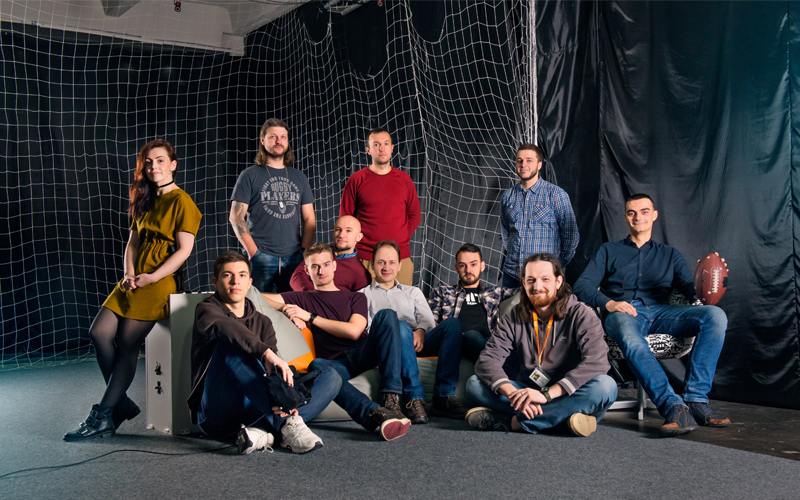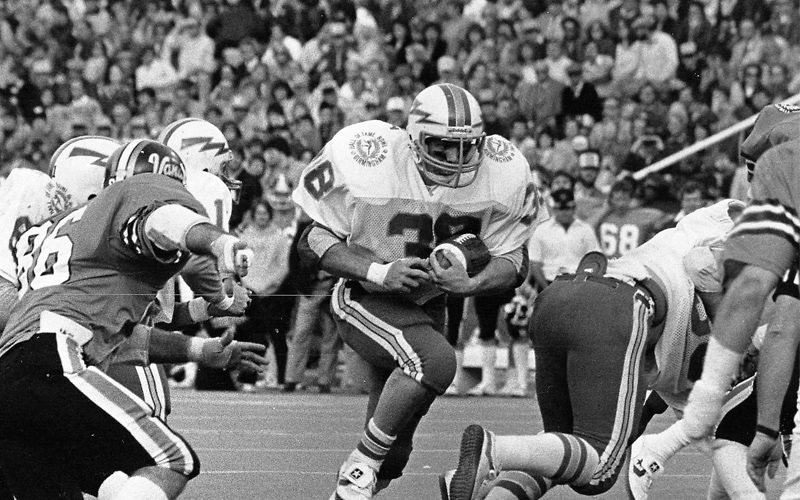Ukrainian IT company N-iX has a Game Development & VR department that offers VR, Cross-Platform Games and Art Production. Daniel Poludyonny, Game & VR Director, and Alina Bohuta, Project Manager, gave us insight into their latest VR project: Sports VTS – a VR Solution Development for Training Simulation in American Football.
Last February, former American Football player and coach Ted Sundquist and the N-iX VR team in Lviv started discussing the development of a VR trainer for quarterbacks, aiming to lower injury rates and to offer an alternative to live practice scenarios on the football field. Virtual Reality is quickly entering the sports world, and it’s revolutionizing the way coaches conduct practice and train their players. Developers are attempting to design simulations so realistic, that the brain treats the experience as if it were actually immersed in the real thing.
With 9 years of U.S. Air Force experience and 16 seasons as an executive for the American football team Denver Broncos, Mr. Sundquist holds a special interest and understanding in tech. N-iX’s VR team is excited to work with him on this project. “When you start developing something like this, you cannot do it without involving really good specialists. Being acquitted with our American contact is a really good thing – he knows trainers, team and association representatives, …” explains Daniel Poludyonny. Alina Bohuta adds: “Because of his professional career experience, we can have real NFL and Collegiate players engaged in the mocap process. The mocap supervisor shoots the animations, cleans the data and sends it to us. Later we integrate them into the Engine. It is very important that the simulation looks realistic.”

Sports VTS is developing the QB SIM as an immersive VR training simulation tool for professional quarterbacks. VR sessions give players an immersive experience that goes far beyond sitting in a dark room, watching replays on tape. The simulator features hyper-realistic 3D graphics and motion capture techniques that track a player’s movements and analyze his performance in real-time. It’s important that the trainer doesn’t look like a video game, but like a professional sports simulator. It has to look as real as possible. So how does this exactly work?
The quarterback enters a dark room with a high ceiling, surrounded by a motion capture array and netting system. In the middle of the room lies a ball with sensor markers and a VR headset. The moment he puts VR goggles on, he’s suddenly immersed in the middle of a football stadium, the crowd cheering him on. Looking down, he sees the ball in front of him and the moment he picks it up, the simulation begins. He sees his receivers running routes and must make the correct pass. When he throws the ball, it actually hits the netting in real life. The program calculates how the ball would travel into the virtual play and the quarterback will see if his pass was complete or not.
From a technical point of view, development of this training simulator is quite a challenge. The trajectory of the ball must be accurately calculated with the help of physics and mathematics, as well as the realistic movements and implementation of the AI (the defender has to know who to cover). The N-iX team developed a catching system based upon a ball grid and created the receiver’s catching animation with the Inverse Kinematics System. They also developed and integrated linebackers and defensive backs into the gameplay for even more realistic and challenging scenarios.
Currently the focus is primarily on the passing game and training/developing quarterbacks. But the team has expanded plans for the project. Soon, high-end data gloves created by Manus VR out of the Netherlands, will be integrated to make the throwing experience and player immersion even more realistic. A regulation football helmet with integrated wireless VR technology will also be implemented. Haptic feedback systems built into the football equipment will give the player the sensation of physical contact without getting actually hit by an opponent.
The near term goal for the team is to go completely wireless. Challenges for all VR projects are accessibility and motion sickness, but the N-iX team believes these issues will be resolved by the technologies scheduled to be integrated into the QB SIM headset. Daniel and Alina are hopeful they begin moving players around in the very near future.

By leveraging the data collected and linked to NFL and NCAA players, the team in Lviv can do a thorough game analysis, as well as player behavior and tendency monitoring. The U.S. team is using a full-body 3D scan for highly-detailed and hyper-realistic character models, sending this information to the Lviv team, where it is inserted into the character customization system building the simulated likeness of actual NFL & Collegiate players. This data is implemented into a State Machine and AI for the lower body detection system and ensures smooth and realistic movements. The team then applies corrective Blend Shapes for recreating a player’s skeleton and body composition.
The developers can adapt the QB SIM to make an individual player run faster and how an individual receiver catches the ball. Power, agility and speed parameters are integrated into the QB SIM and into its complementary application designed specifically for the football coach or trainer. It sets the routes and positions for the players before the actual VR training session. They can then select the play that has to be executed, what the receivers look like, the defensive alignment, and which stadium the quarterback is playing. It’s also possible to change the players’ height, skin tone, uniform color, jersey number and physique. New players, features, and playbooks can be integrated into the system to make the experience as even more realistic. The team really focuses on this element, even designing detailed steps to create the turf on the football field.
Our local American Football team, the Lviv Lions, helps helps our developers test the Sports VTS QB SIM. The QB SIM is still an expensive work in progress and is being initially designed for elite and professional level teams in the United States. Motion capture cameras, can cost upwards to 2k USD each and the QB SIM currently implements a minimum of twelve.
The N-iX team is very proud of their work on the QB SIM, but admit it’s a challenge building something never before seen to this scale. N-iX continues to work closely with Sports VTS and has even invested in the company itself as they continue looking for next level funding. “You’d need to bring people to the facility and show them the product, and or get a mobile unit to take directly to interested parties,” explains Daniel. N-iX and Sports VTS will begin to target NFL and elite level NCAA teams as future users of the QB SIM.
N-iX has a whole department dedicated to the development of games and VR. Aside from the QB SIM, the team has developed Virtual University courses for two clients. The N-iX VR team is eager to build upon that success even further, as a lot of big companies; Walmart, UPS, major sports associations, etc… have begun using VR for training and teaching purposes. N-iX looks to continue to be a part of this emerging market.
